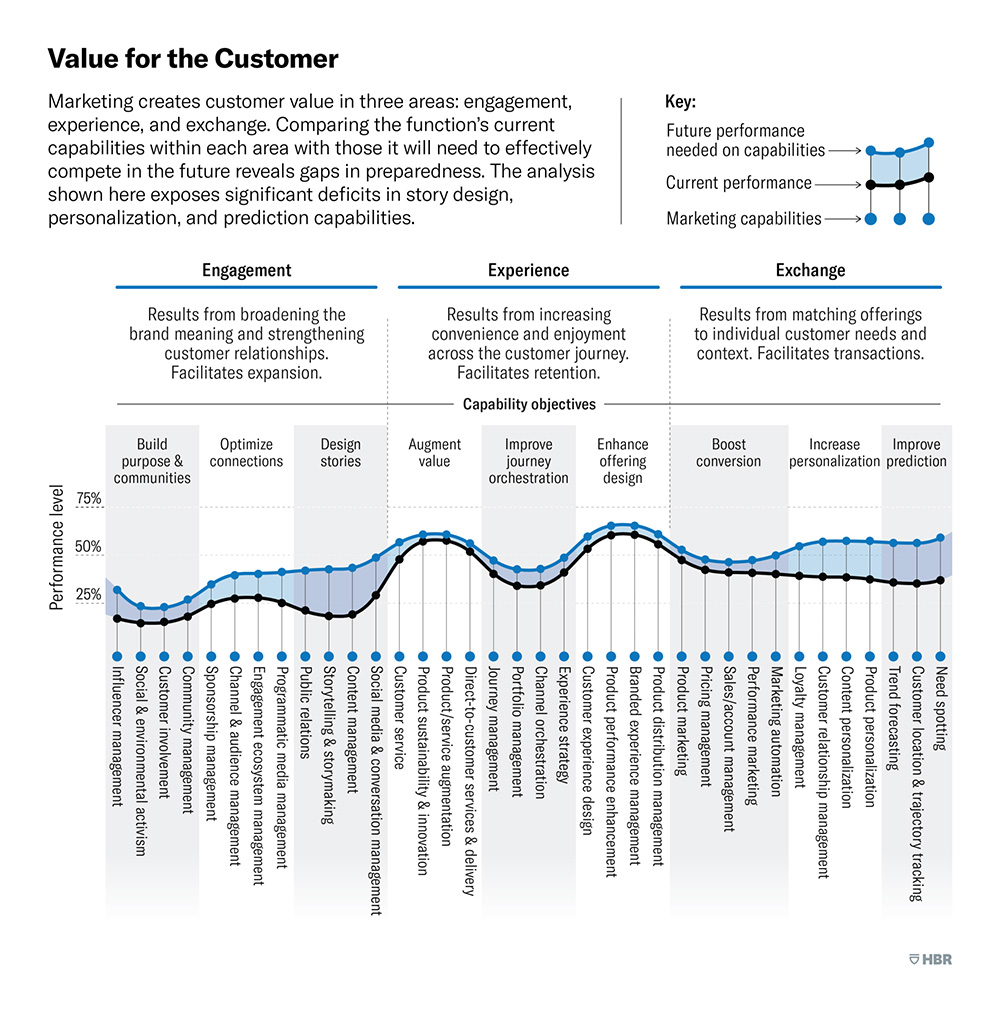
How do marketers create customer value? All too often, we get caught up in hitting our business metrics: sales-qualified leads, conversions, pipeline, conversions, and sales. It’s not that these business outcomes aren’t important; they’re critical. However, we deliver on these business outcomes only when we deliver customer value.
In an influential HBR article titled “Is Your Marketing Organization Ready for What’s Next?” four marketing professors created a taxonomy for understanding how marketers create customer value and where gaps exist today in marketers ability to deliver customer value:

Exchange Value
When most people think of marketing, they think of marketing’s role in creating exchange value. Marketing creates exchange value when it helps an organization sell something by matching customer needs and wants against product and service offerings. Many of the traditional marketing disciplines help to create exchange value: product marketing, pricing, promotion, sales support, and performance marketing.
Perhaps not surprisingly, this is also one of the areas where the gap is the smallest between what’s needed and what most marketing organizations can deliver today. But even here, there are areas for improvement, particularly in the areas of personalization and prediction. If you want to improve your marketing department’s ability to deliver exchange value, ask yourself the following questions:
- How well are we personalizing messaging and content to our customers?
- Are there opportunities to personalize our product and service offerings to our customers?
- Are we doing enough to generate and maintain loyalty among our customers?
- Is marketing leading the company in trend spotting?
- Is marketing forecasting the trajectory of our customers and their future needs? Are we identifying needs customers don’t know they need today but will need tomorrow?
Experience Value
When marketers make it easier for customers to buy and to enjoy the ownership experience, they are creating experience value. This is often a neglected area of marketing.
Perhaps the most familiar approach to creating experience value for most marketers is journey mapping. But many times, journey mapping is done in the service of creating exchange value by optimizing the purchase funnel. Creating experience value requires journey management rather than journey mapping, where the customer’s journey is managed so that the result is customer delight.
If you want to improve your marketing department’s ability to deliver experience value, ask yourself the following questions:
- How can we manage the customer journey to delight customers rather than simply convert them?
- What touchpoints delight our customers? What touchpoints frustrate them?
- How can we augment the value we deliver to customers above and beyond selling to them? For example, Delta Airlines enhances the product they sell – the flight – by “providing advice and information on traffic to and from the airport, in-flight dining choices, boarding status, baggage location, and more.”
- Are there branded experiences you can create that set the standard for customer experience in your industry? Apple’s Genius bar is a classic example, turning what is often considered a cost center (customer support) into a branded source of customer delight.
Engagement Value
Engagement value enhances the “meaning” of a company’s offering—how customers perceive the brand and their relationship with it. Consumers often pay more for products and services from companies that share and promote their values. As the authors of this taxonomy describe it, “Creating engagement value requires marketers to build purpose and communities, optimize connections, and design stories to strengthen customer relationships.”
Building purpose requires an authentic, long-term commitment to an environmental, social, or community cause. It cannot be faked, and often, the ROI isn’t clear in the beginning. But for many brands, the premium they charge comes from marketing delivering engagement value. Think REI and its commitment to the environment, Dove and its commitment to broader conceptions of beauty for girls and women, or Nike and its anti-racism ads.
Engagement value is more than embracing social causes—it is also about optimizing connections and telling stories. Can you bring value to your customers by bringing them together the way that Salesforce does through its Trailblazer community or Microsoft through its Microsoft Professionals and Office Specialists programs?
If you want to improve your marketing department’s ability to deliver engagement value, ask yourself the following questions:
- Is social and environmental activism right for your brand? It’s not for everyone, but for many brands, supporting customer values can result in loyalty and a willingness to pay a premium for your products.
- Can you bring value to your customers by bringing them together? Can your biggest fans help people new to your brand and if so, how can you support and reward them?
- What stories can you tell about your brand or your offerings? How can you strengthen storytelling as a core function of your marketing?
- Does your brand have a strong point of view? Do your customers know and differentiate you based on your point of view?
Marketing's Value Proposition
As marketers, we write value propositions for our organizations and for our products and services. But do we take the time to write a value proposition for ourselves as marketers? What value does marketing deliver to our customers? What value do we deliver to our organizations? Is that value proposition well-known both within and without our organization? Give it a try by writing a value proposition for your marketing department and don’t forget to include exchange, experience, and engagement value.

